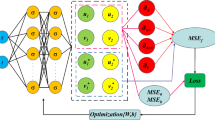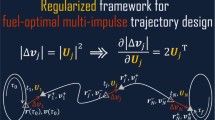Abstract
Modern astronautics problems require methods of tractable uncertainty quantification for problems with data in a variety of mathematical spaces. Polynomial Chaos Expansions (PCEs) enable tractable uncertainty propagation, sensitivity analysis, and provide a surrogate model to efficiently solve stochastic optimization problems. Existing PCE methods are mostly isolated to bases defined via tensor products of univariate functions over subdomains of the real line or integers. The goal of this work is to incorporate random vectors on the n-dimensional sphere, thereby extending the use of PCEs to problems that include spacecraft attitude uncertainty. Random inputs with probability densities on the n-sphere are generally correlated. When directional random inputs are independent, products of univariate functions fail to produce an orthogonal basis. Basis functions must preserve the periodic response of the system produced by the underlying structure of the domain. This paper presents an approach to generating an orthogonal basis with respect to a density function on the n-sphere by combining hyperspherical harmonics with an orthogonalization procedure based on the raw moments of the harmonic functions. For highly concentrated densities on the unit sphere, the spherical cap harmonics provide a more numerically stable solution while preserving periodicity. Numeric errors in the proposed procedure are presented for multiple cases. Performance of the PCEs is quantified when propagating uncertainty for a highly eccentric orbit with a random translational maneuver error, and a second case based on rigid-body dynamics with the attitude state parameterized as a quaternion.














Similar content being viewed by others
Notes
We use an open-source Python wrapper [35] around an established C library for adaptive cubature: https://github.com/stevengj/cubature. Note that, given a node parameterized by \(\theta _1\) and \(\theta _2\), the integrand function used in the software must compute \(Y_{\mu _1,\mu _2}(\theta _1,\theta _2)Y_{\mu '_1,\mu '_2}(\theta _1,\theta _2)\rho (\theta _1,\theta _2)\sin (\theta _2)\) where the additional \(\sin (\theta _2)\) term accounts for integration on a spherical surface.
Based on a serial implementation in Python 3.8.8 running on a MacBook Pro, 2.4 GHz 8-core Intel Core i9 processor with 64 GB of memory.
Provided by Geoff Wawrzyniak of a.i. solutions under contract to NASA.
The MMS satellites each include a GPS receiver and an on-board Kalman filter for navigation purposes. Details on the orbit determination performance at high altitudes may be found in [48]. Per those results, the root-sum-square covariance provided by the navigation filter (in nominal conditions) during Phase I is between 3 and 15 ms in position and between \(10^{-4}\) and \(3\times 10^{-3}\) m/s in velocity. While the test case is on the lower end of those ranges, the scenario is not inconsistent with the realized on-orbit navigation uncertainty.
This work uses the Python wrapper Orthpol (found at https://pypi.org/project/orthpol/ and accessed July 2020) around a C++ implementation of the packaged published in [50] for Stieljes procedure.
References
Jones, B.A., Balducci, M.: Stochastic expansions including data on the unit circle. J. Guid. Control Dyn. 42(12), 2741–2746 (2019). https://doi.org/10.2514/1.G004025
Schmid, C., DeMars, K.J.: Angular correlation using Rogers–Szegő–Chaos. Mathematics 8(2), 171 (2020). https://doi.org/10.3390/math8020171
Junkins, J.L., Akella, M.R., Alfriend, K.T.: Non-Gaussian error propagation in orbital mechanics. J. Astronaut. Sci. 44(4), 541–563 (1996)
Fujimoto, K., Scheeres, D.J., Alfriend, K.T.: Analytical nonlinear propagation of uncertainty in the two-body problem. J. Guid. Control Dyn. 35(2), 497–509 (2012). https://doi.org/10.2514/1.54385
DeMars, K.J., Bishop, R.H., Jah, M.K.: Entropy-based approach for uncertainty propagation of nonlinear dynamical systems. J. Guid. Control Dyn. 36(4), 1047–1057 (2013). https://doi.org/10.2514/1.58987
Horwood, J.T., Aragon, N.D., Poore, A.B.: Gaussian sum filters for space surveillance: theory and simulations. J. Guid. Control Dyn. 34(6), 1839–1851 (2011). https://doi.org/10.2514/1.53793
Jones, B.A., Doostan, A., Born, G.H.: Nonlinear propagation of orbit uncertainty using non-intrusive polynomial chaos. J. Guid. Control Dyn. 36(2), 430–444 (2013). https://doi.org/10.2514/1.57599
Balducci, M., Jones, B.A., Doostan, A.: Orbit uncertainty propagation and sensitivity analysis with separated representations. Celest. Mech. Dyn. Astron. 129(1–2), 105–136 (2017). https://doi.org/10.1007/s10569-017-9767-7
Valli, M., Armellin, R., Di Lizia, P., Lavagna, M.R.: Nonlinear mapping of uncertainties in celestial mechanics. J. Guid. Control Dyn. 36(1), 48–63 (2013). https://doi.org/10.2514/1.58068
Jones, B.A., Doostan, A.: Satellite collision probability estimation using polynomial chaos expansions. Adv. Space Res. 52(11), 1860–1875 (2013). https://doi.org/10.1016/j.asr.2013.08.027
Jones, B.A., Parrish, N., Doostan, A.: Postmaneuver collision probability estimation using sparse polynomial chaos expansions. J. Guid. Control Dyn. 38(8), 1425–1437 (2015). https://doi.org/10.2514/1.G000595
Feldhacker, J.D., Smith, J., Jones, B.A., Doostan, A.: Multi-element trajectory models for satellite tour missions. In: Proceedings of the AIAA/AAS Astrodynamics Specialist Conference, AIAA 2016-5502, Long Beach, CA (2016)
Balducci, M., Jones, B.A.: Probability of collision estimation and optimization under uncertainty utilizing separated representations. J. Astronaut. Sci. 67, 1648–1677 (2020). https://doi.org/10.1007/s40295-020-00218-z
Soize, C., Ghanem, R.: Physical systems with random uncertainties: Chaos representations with arbitrary probability measure. SIAM J. Sci. Comput. 26(2), 395–410 (2004). https://doi.org/10.1137/S1064827503424505
Feinberg, J., Eck, V., Langtangen, H.: Multivariate polynomial chaos expansions with dependent variables. SIAM J. Sci. Comput. 40(1), 199–223 (2018). https://doi.org/10.1137/15M1020447
Jones, B.A.: Modeling attitude-dependent maneuver errors with polynomial chaos expansions. In: Proceedings of the AAS/AIAA Space Flight Mechanics Meeting, Ka’anapali, HI (2019)
Jones, B.A., Wolf, T.: Attitude state uncertainty propagation using stochastic expansions. In: Proceedings of the 31st Annual AAS/AIAA Space Flight Mechanics Meeting, Virtual Conference (2021)
Wiener, N.: The homogeneous chaos. Am. J. Math. 60(4), 897–936 (1938). https://doi.org/10.2307/2371268
Ghanem, R.G., Spanos, P.D.: Stochastic Finite Elements: A Spectral Approach. Dover, New York (2002)
Xiu, D., Karniadakis, G.E.: The Wiener–Askey polynomial chaos for stochastic differential equations. SIAM J. Sci. Comput. 24(2), 619–644 (2002). https://doi.org/10.1137/S1064827501387826
Eldred, M.S.: Design under uncertanity employing stochastic expansion methods. Int. J. Uncertain. Quantif. 1(2), 119–146 (2011)
Gautschi, W.: On generating orthogonal polynomials. SIAM J. Sci. Stat. Comput. 3(3), 289–317 (1982). https://doi.org/10.1137/0903018
Wan, X., Karniadakis, G.E.: Multi-element generalized polynomial chaos for arbitrary probability measures. SIAM J. Sci. Comput. 28(3), 901–928 (2006). https://doi.org/10.1137/050627630
Oladyshkin, S., Nowak, W.: Data-driven uncertainty quantification using the arbitrary polynomial chaos expansion. Reliab. Eng. Syst. Saf. 106, 179–190 (2012). https://doi.org/10.1016/j.ress.2012.05.002
Jakeman, J.D., Franzelin, F., Narayan, A., Eldred, M., Plfüger, D.: Polynomial chaos expansions for dependent random variables. Comput. Methods Appl. Mech. Eng. 351, 643–666 (2019). https://doi.org/10.1016/j.cma.2019.03.049
Gill, P.E., Murray, W., Wright, M.H.: Practical Optimization, 1st edn. Society for Industrial and Applied Mathematics, Philadelphia (1981)
Rynne, B.P., Youngson, M.A.: Linear Functional Analysis, 2nd edn. Springer, London (2008)
Hosder, S., Walters, R.W., Perez, R.: A non-intrusive polynomial chaos method for uncertainty propagation in CFD simulations. In: Proceedings of the 44th AIAA Aerospace Sciences Meeting and Exhibit, AIAA 2006-891, Reno, Nevada (2006)
Doostan, A., Owhadi, H.: A non-adapted sparse approximation of PDEs with stochastic inputs. J. Comput. Phys. 230(8), 3015–3034 (2011). https://doi.org/10.1016/j.jcp.2011.01.002
Pati, Y.C., Rezaiifar, R., Krishnaprasad, P.: Orthogonal matching pursuit: Recursive function approximation with applications to wavelet decomposition. In: Proceedings of 27th Asilomar Conference on Signals, Systems and Computers, pp. 40–44 (1993). https://doi.org/10.1109/ACSSC.1993.342465
Davis, G., Mallat, S., Avellaneda, M.: Adaptive greedy approximation. Constr. Approx. 13(1), 57–98 (1997). https://doi.org/10.1007/BF02678430
Donoho, D.L.: Compressed sensing. IEEE Trans. Inf. Theory 52(4), 1289–1306 (2006). https://doi.org/10.1109/TIT.2006.871582
Avery, J.E., Avery, J.S.: Hyperspherical Harmonics and Their Physical Applications. World Scientific Publishing Company, Singapore (2017)
Domokos, G.: Four-dimensional symmetry. Phys. Rev. 159(5), 1387–1403 (1967). https://doi.org/10.1103/PhysRev.159.1387
Castro, S.G.P., Loukianov, A.: Python Wrapper for Cubature: Adaptive Multidimensional Integration. https://doi.org/10.5281/zenodo.3715624. https://github.com/saullocastro/cubature/tree/v0.14.5
Dai, F., Xu, Y.: Approximation Theory and Harmonic Analysis on Spheres and Balls. Springer, New York (2013)
Haines, G.V.: Spherical cap harmonic analysis. J. Geophys. Res. Solid Earth 90(B3), 2583–2591 (1985). https://doi.org/10.1029/JB090iB03p02583
Brent, R.P.: Algorithms for Minimization Without Derivatives. Dover Publications Inc, New York (2002)
Torta, J.M.: Modelling by spherical cap harmonic analysis: a literature review. Surv. Geophys. 41(2), 201–247 (2020). https://doi.org/10.1007/s10712-019-09576-2
Kent, J.T.: The Fisher–Bingham distribution on the sphere. J. R. Stat. Soc. Ser. B (Methodol.) 44(1), 71–80 (1982)
Mardia, K.V., Jupp, P.E.: Directional Statistics. Wiley, Chichester (2000)
Bingham, C.: An antipodally symmetric distribution on the sphere. Ann. Stat. 2(6), 1201–1225 (1974)
Kent, J.T., Ganeiber, A.M., Mardia, K.V.: A new unified approach for the simulation of a wide class of directional distributions. J. Comput. Graph. Stat. 27(2), 291–301 (2018). https://doi.org/10.1080/10618600.2017.1390468
Prince, R.J., Dormand, J.R.: High order embedded Runge–Kutta formulae. J. Comput. Appl. Math. 7(1), 67–75 (1981). https://doi.org/10.1016/0771-050X(81)90010-3
Lemoine, F.G., Kenyon, S.C., Factor, J.K., Trimmer, R.G., Pavlis, N.K., Chinn, D.S., Cox, C.M., Klosko, S.M., Luthcke, S.B., Torrence, M.H., Yand, Y.M., Williamson, R.G., Pavlis, E.C., Rapp, R.H., Olson, T.R.: The development of the joint NASA GSFC and NIMA geopotential model EGM96. Technical Report NASA/TP-1998-206861, NASA Goddard Space Flight Center, Greenbelt, Maryland, 20771, USA (1998). http://cddis.nasa.gov/926/egm96/egm96.html
Folkner, W.M., Williams, J.G., Boggs, D.H.: The planetary and lunar ephemeris DE421. IPN Progress Report 42-178, Jet Propulsion Laboratory, California Institute of Technology, http://ipnpr.jpl.nasa.gov/progress_report/42-178/178C.pdf (2009)
Petit, G., Luzum, B.: IERS conventions (2010). IERS Technical Note 36, International Earth Rotation and Reference Systems Service (IERS), Frankfurt am Main, Germany (2010)
Winternitz, L.B., Bamford, W.A., Price, S.R., Carpenter, J.R., Long, A.C., Farahmand, M.: Global positioning system navigation above 76,000 km for NASA’s Magnetospheric Multiscale mission. Navigation 64(2), 289–300 (2017). https://doi.org/10.1002/navi.198
Xiu, D.: Numerical Methods for Stochastic Computations: A Spectral Method Approach. Princeton University Press, Princeton (2010)
Gautschi, W.: Algorithm 726: ORTHPOL-a package of routines for generating orthogonal polynomials and Gauss-type quadrature rules. ACM Trans. Math. Softw. 20(1), 21–62 (1994). https://doi.org/10.1145/174603.174605
Sudret, B.: Global sensitivity analysis using polynomial chaos expansions. Reliab. Eng. Syst. Saf. 93(7), 964–979 (2008)
Saltelli, A.: Making best use of model evaluations to compute sensitivity indices. Comput. Phys. Commun. 145(2), 280–297 (2002). https://doi.org/10.1016/S0010-4655(02)00280-1
Darling, J.E., DeMars, K.J.: Uncertainty propagation of correlated quaternion and Euclidean states using the Gauss–Bingham density. J. Adv. Inf. Fus. 11(2), 186–205 (2016)
Gilitschenski, I., Kurz, G., Julier, S.J., Hanebeck, U.D.: Unscented orientation estimation based on the Bingham distribution. IEEE Trans. Autom. Control 61(1), 172–177 (2016). https://doi.org/10.1109/TAC.2015.2423831
Kurz, G., Gilitschenski, I., Julier, S., Hanebeck, U.: Recursive Bingham filter for directional estimation involving 180 degree symmetry. J. Adv. Inf. Fus. 9(2), 90–105 (2014)
Acknowledgements
The Python-based implementation of the OMP solver is based on the MATLAB code in SparseLab (Available at http://sparselab.stanford.edu [retrieved May 2013].). Evaluation of the Gegenbauer polynomials uses the C++ implementation available online from John Burkardt, Florida State University (Available at https://people.sc.fsu.edu/\(\sim\)jburkardt [retrieved July 2020]). The modified Cholesky decomposition is computed using the implementation provided as part of the chaospy software package(https://github.com/jonathf/chaospy [retrieved July 2020]). Evaluation of the partial derivatives of the Kent PDF normalization constant used the Kent distribution software available online (https://github.com/edfraenkel/kent_distribution [retrieved July 2020]), which was edited by the authors to improve numeric stability for large concentration parameters.
Author information
Authors and Affiliations
Corresponding author
Ethics declarations
Conflict of interest
On behalf of all authors, the corresponding author states that there is no conflict of interest.
Additional information
Publisher's Note
Springer Nature remains neutral with regard to jurisdictional claims in published maps and institutional affiliations.
Appendices
Appendix A Derivation of Basis for Symmetric Densities
Combining Eqs. (49), (33), and (10) for the Kent distribution with \(n=2\) and \(\beta =0\),
with multi-indices \(i=(\mu _0,\mu _1,\ell )\) and \(j=(\eta _0,\eta _1,k)\). Focusing on the case \(\ell = k = 0\), then
Similarly, for \(\ell =k=1\),
and for the case of \(\ell \ne k\),
Hence,
Substituting Eq. (A10) and the definition of \(\rho (\theta _2)\) into (A2),
Appendix B Description of Linear Post-maneuver Solution
This appendix briefly describes the method used to approximate the propagated deviation in the trajectory using traditional linearization-based methods. Due to the definition of the inputs \(\theta _1\) and \(\theta _2\), namely the mean vector corresponding to the singularity at the pole in the canonical basis, the problem is ill-defined when examining deviations in the random inputs in a linearized approach. Instead, we model the variations in the maneuver direction by angles \(\alpha\) and \(\beta\) relative to the nominal maneuver direction, and
Angles \(\theta _1\) and \(\theta _2\) may be transformed to \(\alpha\) and \(\beta\) through \(\varvec{x}\).
Let \(\varvec{s}(t) = \begin{bmatrix} \varvec{r}(t)^T&\varvec{v}(t)^T\end{bmatrix}^T\) be the translation state vector at time t. A maneuver performed at \(t_m\) is modeled as impulsive with velocity change \(\Delta \varvec{v}\) as in Eq. (56) for a given \(\varvec{x}\). The variables \(\varvec{s}_m^+\) and \(\varvec{s}_m^-\) denote the post- and pre-maneuver state, respectively, and
The start and end epochs of the scenario are \(t_0\) and \(t_f\) with \(t_0< t_m < t_f\). As in Eq. (56), the maneuver is assumed to be independent of \(\varvec{s}(t_m)\). Group the initial state and maneuver parameters into the vector
Let \(\varvec{s}^*(t_f)\) be the propagated state given initial conditions and maneuver parameters \(\varvec{\lambda }_0^*\). We wish to determine the approximate solution \(\varvec{s}(t_f)\) that corresponds to the initial conditions \(\varvec{\lambda }_0 = \varvec{\lambda }^*_0 + \Delta \varvec{\lambda }_0\), where \(\Delta \varvec{\lambda }_0\) is a deviation relative to a nominal vector \(\varvec{\lambda }^*_0\). We will generate the solution
Hence,
where \(\varvec{\Phi }_{i,j}\) is the state transition matrix from time \(t_j\) to time \(t_i\) with reference trajectory \(\varvec{\lambda }^*_0\). The partials with respect to \(\alpha\) and \(\beta\) are then found by differentiating Eq. (B12).
The accuracy of this approach based on linearization is compared to the PCE-based surrogate using the same samples. The evaluated partials Eq. (B13) and the final reference trajectory \(\varvec{s}^*(t_f)\) are generated once given the initial mean of the prior PDF with \(\alpha ^*\) and \(\beta ^*\) equal to zero radians. For each random input vector, \(\varvec{s}(t_0,\varvec{\xi }) - \varvec{s}^*(t_0)\), \(\alpha (\varvec{\xi })\), and \(\beta (\varvec{\xi })\) are computed to yield \(\Delta \varvec{\lambda }_0(\varvec{\xi })\). Finally, the RMS error is based on the position elements of the vector
over all points considered in the analysis.
Rights and permissions
Springer Nature or its licensor (e.g. a society or other partner) holds exclusive rights to this article under a publishing agreement with the author(s) or other rightsholder(s); author self-archiving of the accepted manuscript version of this article is solely governed by the terms of such publishing agreement and applicable law.
About this article
Cite this article
Jones, B.A., Wolf, T.N. Incorporating Directional Uncertainties into Polynomial Chaos Expansions for Astronautics Problems. J Astronaut Sci 70, 19 (2023). https://doi.org/10.1007/s40295-023-00380-0
Accepted:
Published:
DOI: https://doi.org/10.1007/s40295-023-00380-0




